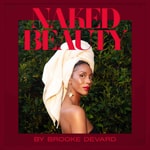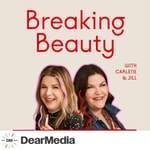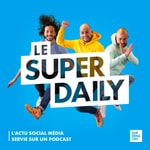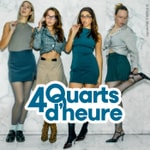Makers of the USA – Détails, épisodes et analyse
Détails du podcast
Informations techniques et générales issues du flux RSS du podcast.
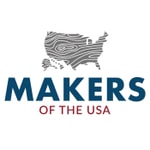
Makers of the USA
Kristan Vermeulen
Fréquence : 1 épisode/19j. Total Éps: 97

Classements récents
Dernières positions dans les classements Apple Podcasts et Spotify.
Apple Podcasts
🇺🇸 États-Unis - design
28/07/2025#97🇺🇸 États-Unis - design
06/03/2025#97🇺🇸 États-Unis - design
04/12/2024#65🇺🇸 États-Unis - design
08/11/2024#98
Spotify
Aucun classement récent disponible
Liens partagés entre épisodes et podcasts
Liens présents dans les descriptions d'épisodes et autres podcasts les utilisant également.
See all- https://www.instagram.com/stories
1743 partages
- https://www.instagram.com/nickrossiknives
11 partages
- https://atlanticseafarms.com/
12 partages
- https://nickrossiknives.com/
8 partages
- https://lonepinebrewery.com/
7 partages
Qualité et score du flux RSS
Évaluation technique de la qualité et de la structure du flux RSS.
See allScore global : 63%
Historique des publications
Répartition mensuelle des publications d'épisodes au fil des années.
Indigo Arts Alliance Builds Artist Relationships that Last a Lifetime
Épisode 83
mercredi 9 octobre 2024 • Durée 38:54
Jordia Benjamin, recognized in MaineBiz's "40 Under 40," is a prominent figure in the arts community. As the Executive Director of Indigo Arts Alliance, she focuses on supporting artists of color and fostering cultural representation. Benjamin's leadership emphasizes collaboration, creativity, and community engagement. Her work has significantly impacted the Maine arts landscape, promoting diversity and inclusion while nurturing emerging talent. Through her initiatives, she aims to inspire social change and enhance the visibility of underrepresented artists.
Kristan speaks to Jordia about her previous careers that helped her get to where she is today. The ones that have a really special place are those that continue to have an impact today. Twelve years ago, under the auspices of the National Art Gallery of the Bahamas, she created the first teacher's art resource guide (over 100 pages) that provided an art curriculum for each grade school level based on Bahamian artists and history. The guide is still in use today.
In addition to her work on an art resource guide, she fostered a program allowing gifted emerging Bahamian artists to exhibit their work alongside Bahamian masters in conjunction with the gallery, many of whom are now represented by international galleries and have exhibited in international museums.
Today, her work at Indigo Arts Alliance allows her to advance the professional development of Black and Brown artists aligning with her moral compass. With an amazing team, they can advance through their residency program, the artistic excellence of local/national and global creatives.
You can learn more about Indigo Arts Alliance by visiting their website.
If you enjoyed this Makers of the USA episode, please leave a rating and review on Apple Podcasts, Spotify or Facebook. Please check out Makers of the USA's YouTube channel, Facebook and Instagram. Thank you all and stay safe and healthy.
Discovering the Artistry of Organ Building with Martin Pasi
Épisode 88
jeudi 28 décembre 2023 • Durée 01:13:08
[00:02:56] Organ building craftsmanship.
[00:03:58] Organ building and inspiration.
[00:10:37] Knowing music for organ building.
[00:14:22] Perfect facility for craft.
[00:20:53] The cost of organs.
[00:21:43] Organ building as mechanical design.
[00:27:11] Moon and farming practices.
[00:30:43] Two temperaments in organs.
[00:38:15] Organ pipes collapsing over time.
[00:40:21] Organ builders and bone materials.
[00:45:09] The gold leaf process.
[00:48:06] The weight of the organ.
[00:52:02] Community involvement in instrument care.
Organ building is a complex and intricate process that demands a significant investment of time and financial resources. In the episode, it is highlighted that churches and other organizations often face the challenge of securing funding and going through a lengthy organizational process before they can even begin constructing an organ. This can take years to accomplish as they work towards securing the necessary funds and finalizing arrangements.
The episode also sheds light on the cost of building an organ. It is mentioned that the average cost of an organ is around a million dollars, although this can vary depending on the size and complexity of the instrument. Larger organs can cost up to two million dollars or even more, while smaller organs may be priced at around five hundred thousand dollars.
The episode emphasizes the crucial role of careful planning and design in organ building. Before commencing the construction process, the organ builder must create a detailed design that ensures all components fit together harmoniously and allows each pipe to have sufficient space to produce sound. This meticulous process involves laying out thousands of pipes on templates and ensuring each one is of the correct size and position.
Organ building is a costly and time-consuming endeavor that necessitates extensive planning, funding, and organization. It is a process that requires both craftsmanship and artistry and scientific and mathematical skills.
The episode discusses the average cost of an organ, which is approximately a million dollars. The host inquires about the cost of organs, and the builder confirms that a million dollars is a typical average cost. However, the builder also mentions that the cost can vary, potentially reaching two million dollars or more for larger organs, or as low as five hundred thousand dollars for smaller organs. Therefore, while a million dollars is the average, the actual cost depends on the size and complexity of the organ.
Martin initially developed a passion for organ building at the age of 15. However, their parents discouraged them from pursuing it at that time, leading them to choose a business high school instead. Despite this, the desire to become an organ builder never left their mind.
After completing high school and entering adulthood, Martin felt a strong urge to engage in a craft and work with their hands. Organ building remained a lingering passion. Fortunately, they secured an apprenticeship position with a well-known and reputable organ-building company. Through this apprenticeship, they acquired the necessary skills and knowledge to install organs, tune them, and perform maintenance.
Eventually, Martin had the opportunity to travel to the United States multiple times a year for work. They received job offers from various organ builders, first in Minnesota and then in the Montreal area of Canada. Finally, they decided to move to the United States and work with another organ builder who intrigued them. This experience ultimately led the host to establish their own organ-building business.
Despite initially facing discouragement from their parents, Martin's passion for organ building never wavered. They pursued their passion, gained experience and knowledge through apprenticeships and job opportunities, and eventually established their own successful business in the field.
If you enjoyed this Makers of the USA episode, please leave a rating and review on Apple Podcasts, Spotify or Facebook. Please check out Makers of the USA's YouTube channel, Facebook and Instagram. Thank you all and stay safe and healthy.
Gnykol Takes Recycled Leather & Tranforms It Into Rockstar Inspired Apparel
Épisode 79
mardi 14 mars 2023 • Durée 27:56
" I define myself as a leather art wear designer so which means that I make one-of-a-kind pieces of art fashion using recycled leather. How I got into that -- long funny story but it really came down to my friend asking me in his driveway if I wanted to sew leather jackets together. My experience sewing before that was minimal. I had a sewing machine. My mom got me from Walmart and knew how to do some really basic straight stitches on jeans and didn't repair things. But I always had an interest in sewing and so I said yes and three years later here I am making jackets and vests and bustiers -- one-of-a-kind pieces," said Nicole or Gnykol, a fashion designer based in Bath.
Nicole's passion started in Ashville, North Carolina where her and her friends would cut pieces of used leather and turn them into all types of things. She never thought that passion would turn into a career.
Barney and J.M. are clay polymer artists and J.M. went on out on his own to do wearable art. So I modeled I hate modeling. I found that out pretty quickly. But it was great to work with them. Our friendship stayed intact and it was over the years we stayed in touch which led to the driveway question do you want to sell leather jackets? So J.M. had been working with leather and caught me up to speed when we started working together he brought me up to everything that he knew. And from there we learned a lot together in that process I'd say maybe six months in J.M. helped me up he gave me the means to have my own studio space, helped me get a work table, encouraged me to get the materials and tools that I needed, including sewing machine, we spent some of our COVID money buying sewing machines together, which was really fun, and fascinating. Six months and I started to have my own space and my own tools. That's when I started to branch out and start making my own thing. So J.M. was really focused on his jackets, and has been continuing on the jacket path whereas I took off and started making bustiers. So we make very different items from the beginning, we just started to start a collective. Our collective is called True Self Couture. So it's not just leather art, it's wearable art. The idea is that its everyday art, where it's pieces of art fashion that you can wear every single day, no matter where you're going, what you're doing. It's expressive, it's inspiring. It's one of a kind and it's to empower the wearer and just inspires the people around you," said Nicole.
Nicole hopes to create wearable art for musicians, other artists, and celebrities. But the most important thing is that she crafts pieces for all.
"One of the main focuses of my work is to make couture pieces to make to order so that way no matter what your size and shape is no matter what your intention is I make for you, so you're not just buying something that you know is a medium. You are a medium, it's a little loose here, it doesn't quite fit there and it's just I want to make you feel like a rockstar. I've had some fantastic friends support me and some of my friends are cool. One of my friends just wore one of my bustiers that I made for her which is covered in these dragon spikes, she wore it to her brother's wedding and over a ballgown, and she looked, killer. I have performers that have ordered my work, everything from musicians to drag performers, I had a commission from a lady, a mature woman over 60. She just fell in love with the jacket I had down in the gallery here in Bath. I was so flattered that she wanted one of my jackets because it was not the age demographic that I thought would be interested in my jacket. But lo and behold, she was so really excited to have her support," said Nicole.
Tune into the episode to learn more about Nicole -- her past and the future of her fashion career.
If you enjoyed this Makers of the USA episode, please leave a rating and review on Apple Podcasts, Spotify or Facebook. Please check out Makers of the USA's YouTube channel, Facebook and Instagram. Thank you all and stay safe and healthy.
Philip Costello Creates Sculptures & Carvings Through The Beauty Of Natural Wood
Épisode 78
samedi 4 mars 2023 • Durée 35:06
"I guess in my particular case, the wood sculpture would be more of a definition of what I do. A traditional wood carver uses chisels and gouges only that are very specific. I've found that using some electric tools and sanding, I can sometimes bring the piece to the point that I like. So I'm more of a wood sculptor than I am a wood carver so to speak. A traditionalist would be a wood carver, I'm a wood sculptor. I've always been intrigued since a young child, I've always enjoyed drawing. My grandmother was a tremendous drawer and painter, my Dad loved to draw and I love to draw. I've always wanted to carve but of course, life gets in the way of so many things and work and life and children and families and that sort of thing but was able to retire early. I said you know when I retire, which was proximately nine years ago, I'm going to start carving and I've been carving ever since," said Phil Costello.
Phil and his wife had a store in Maine where they sold beach decor and home furnishings. The manager at Cliff House, Nancy White, came to their store to buy some of their product at one time when they were doing some renovation at the Cliff House. She saw Phil at the studio and she said, "I'd like you to do a seven-foot carving for us for our Discovery Center." And Phil said "a seven-foot carving is an awful large carving. Nancy, said, "I just like some height, because I'd like it to be a focal point in the middle of Discovery Center." A beautiful whale that Phil crafted now sits in this space and it's a beautiful piece especially when the daylight shines in through the windows and hits it perfectly showing its beautiful markings. He absolutely loves what he does and the craft seems so simple yet it can be challenging.
"Okay, first and most importantly, what are we going to design on? What is our design, what's our sculpture going to be? Sometimes we'll even do it in clay to kind of get a handle on what we think is best. And once we get a good idea as to what we want to sculpt or what we want to carve in the design and then we decide on the wood. There are probably half a dozen woods that are used for carving. There are a few that I've kind of prioritized over the years. Mahogany is one of the best woods to carve because it's very hard. It's very dense. It's got beautiful grain, but because it's very hard and very dense it's very difficult to carve and it's also very hard on your tools you have to sharpen more often. The other woods that you'd use would be butter, not basswood, I use a lot of Spanish cedar spanish. Cedar is a little bit lighter than mahogany, but darker than basswood, which are butternut, which is very light-colored wood. And it's got some beautiful grains to it. But most importantly, it's very soft. So the selection of wood would be the first one. And then what I would do is quite often when I design I try to bring my design in proportion to whatever I'm trying to design. Right now I'm working on an eagle. Obviously, I don't have a six-foot wings spread, but the eagle that I'm working on now is a four-foot wings spread. So then you have to proportionate correctly. Problem is when you're doing a large carving it is very difficult if not impossible to find a large piece of wood. So what you have to do is buy wood I buy it actually rough sawn, I then have a shop where I bring it down to edge. What I do is glue the blocks together in the form of the shape of what the carving is going to be starting with tools to take the major wood away what we call boasting or taking the larger pieces away till we get a rough, rough idea of what the actual carving is. And then we started with the finer tools to bring it down and hone it to the shape and size and detail that we want. That's basically it. And then most importantly, which I sometimes have a challenge with is the finishing of it is as good a woodcarver as I like to be or, or progressing towards, I still haven't perfected the art of finishing. So either my wife who is a painter, and finisher, or I'll bring it to a finishing shop and let them do the finish coat on it. Because when you spend a lot of time you've completed a beautiful carving and if you're you're it's time to have the finish, you can't go guessing as to the right thing to do you have to have somebody that's a specialty at that doing that type of work for you," said Phil.
To learn more about Phil's wood sculpting career, who inspired him, and what he plans for the future, tune in to this episode.
If you enjoyed this Makers of the USA episode, please leave a rating and review on Apple Podcasts, Spotify or Facebook. Please check out Makers of the USA's YouTube channel, Facebook and Instagram. Thank you all and stay safe and healthy.
Chef Tara Cannaday Pairs Nostalgic Flavors With Delightful Surprises & Each Treat Includes A Secret Ingredient That Makes Her Craft Truly Special
Épisode 77
samedi 4 février 2023 • Durée 37:31
"I am a pastry chef, classically trained. I've been in food now for 14 years. I will say I've been cooking and baking since I was very little I grew up on a farm in Florida and always had really fresh produce and meat as well to use to cook with. And a lot of time with my mother in the kitchen," said Chef Tara Cannaday, head chef of Pot + Pan, "I was born in Florida and stayed there until I was 12 and then actually moved to New Hampshire, Southern New Hampshire with my mom and my brother. My mom's side of the family is from New Hampshire. So went to high school there and then ended up in Boston for music school. Music was my first career and enjoyed cooking and entertaining along the way. Like when I was in high school I was always in drama club and whenever we would have like, you know, team building events, if you will, or cast parties, I was always the one that was making treats and food. It certainly continued into college when we are at music school like poor college musicians, trying to do little potlucks and things I would always be like, you know what I got this guys I'm going to take my paycheck from the week and make a big spread of food."
From there, Chef Tara Cannnaday took on many roles with five-star restaurants but eventually took her career to Maine. She started a food truck where she sold the best macaroons in East Prom in Portland and now is the head chef at Pot + Pan, a cannabis edible company that puts food first.
"I was still very heavily involved in my own business, leading up to COVID. My daughter was getting older at this point and I felt a little bit more of a need to be home with her more often and have a more consistent schedule, which I wasn't getting with my own business. And, you know, still love what I did, but need to kind of have a greater purpose in what I was doing. So Pot + Pan had posted an ad online that they were looking for a baker. And I was like, You know what, I'm very passionate about the cannabis space. Something that you know is medicinal and helps people and I love helping people. So I reached out and said, Hey, this is what I can do. I think I can offer this to you all. And yeah, they went for it. Kerry John, who's one of the owners actually had already known about my business and was a fan. So they told me they were very excited when, when my resume came through, I think they meant it. Yeah, I was just so thrilled to have the opportunity. And it really kind of created this new challenge for me food-wise. Sure, you know, cannabis is, is a medicine, but it's really just an ingredient. And I call it my like, little secret ingredient. Because that's, that's all it is. So I'm still creating food that I love and with, you know, purpose and thought, I have this little extra secret ingredient that makes you feel good, right? And that's, that's really what we're all about here. So anytime I'm planning menus, I approach it like I would if there was no cannabis. Honestly, I feel like I've finally found where I have been meant to be this whole time. I'm so grateful for the journey that has brought me here. But now I'm like, I'm really in it. And I'm loving all of the people that I'm meeting as a result of being a part of this business great. And being able to be the forward-facing person like, yeah, it really plays into what I did as a musician and a performer earlier on," said Tara.
Tara's goal is to not only bring her delicious recipes to the table with Pot + Pan but to educate people of edibles and how they can approach it through their lifestyle.
We're trying to take this unique approach to cannabis where Moms and people who are curious will feel like it's approachable and easy and comfortable. Not having to go into a store where it's a bunch of, for lack of a better term stoners who might judge you if you're only in there trying to buy a five-milligram gummy as opposed to 100-milligram gummy. We are trying to be approachable and say like, Hey, you can trust us -- like our products as they are accurately dosed always. They're delicious, and you know that you will have a consistent experience, right? It is very shareable. I think we're creating something really fun and different that no one is doing in cannabis right now. It feels exciting. It feels a little scary at times, because we're like, wait a second, are people going to see this vision as we do? And now we see the feedback and it has been great," said Tara.
Tune in to learn more about Tara, her past career, her experience as head chef at Pot + Pan and her future goals with the company.
If you enjoyed this Makers of the USA episode, please leave a rating and review on Apple Podcasts, Spotify or Facebook. Please check out Makers of the USA's YouTube channel, Facebook and Instagram. Thank you all and stay safe and healthy.
Catherine Fisher Turns Her Beautiful Words Inspired By One's Personal Quest Into Physical Form
Épisode 76
vendredi 20 janvier 2023 • Durée 36:49
"My craft is currently a collection of sustainable clothing, where each design springs from the meaning of a particular poem. I did an MFA in poetry. I went back to doing that when I turned 50. After my experience there I just started to see some of the poems in physical form as garments," said Catherine Fisher, poet and fashion designer who is located in Brunswick, Maine.
Catherine is originally from Massachusetts and had quite the journey before starting her own business.
"I went to a women's college and my major was philosophy -- a very practical major. I have done a lot of different things in my life. I was a clown and then a dental assistant and then I owned an inn and restaurant in the White Mountains of New Hampshire before I moved to Portland, and then I became a personal historian working with people to write their life stories, company histories, family histories, and then I went to Shiatsu school and I did acupressure for a while," said Catherine.
The most difficult part when getting into her own craft and business was sharing it with others.
"As kids being first introduced to poetry, I really thought it as a kind of a magical thing, once I kind of got what it was, you know. And then I think I did some, as an angsty teenager, but I really didn't write very much until I did the MFA. I was surrounded by poets. I was married to a poet, a very established poet. And so that was part of my path. It gave me an assignment and I had to do it and I had to share it. Sharing it was the most difficult part of it. I really feel like my MFA experience was a way of becoming a grown-up really. It was hard for me to put myself out there, show my work, or do anything. It's gotten easier, but it's not easy. Still, for me, this is a big deal for me to put myself out there this way, I'm still pretty shy," said Catherine.
Once Catherine got into the swing of her poetry she took her craft to the next level by crafting small-batch pieces made from sustainable fabrics that were visuals stemmed from her poetry.
"Well, the poems definitely spring right from my life, for sure. Then I think that I hope that there's something universal, you know, I mean, we are all one stuff really all connected. And so I think, I'm not sure I mean, that I can say, why the garment from the poem. Like, why do that, except that, how we adorn ourselves, you know, it is part of our identity. And that, in bringing ourselves out into the world, to connect with other people, we want to feel good, we want to feel like what we are wearing, it is reflective of how we're feeling and who we are. And now, I mean, I feel best, sometimes in my jumpsuit that's covered with paint and dirt, and, you know, I'm happy," said Catherine.
Tune in to learn more about Catherine's past career, where she is at today with her poetry and beautiful fashion pieces that go along with them, and how people connect with her pieces.
If you enjoyed this Makers of the USA episode, please leave a rating and review on Apple Podcasts, Spotify or Facebook. Please check out Makers of the USA's YouTube channel, Facebook and Instagram. Thank you all and stay safe and healthy.
The Mallett Brothers Band Takes Historic Logging Shanties & Make It There Own
Épisode 75
lundi 9 janvier 2023 • Durée 42:47
"We probably owe it to the Portland music scene as an entity, mostly, you know, we all knew each other. It's a tight, tight-knit scene. It's a very supportive scene. There were a lot of great clubs that we all knew when we were getting started and we'd all been playing in the clubs and working in the clubs and spending every free second in places like Big Easy. So the scene was a great place to pull from. So when we started, we ended one project and we started writing songs. Me and Will and Nick, originally on our, on our couch with me and Nick were roommates. Within like a couple of weeks, Nick kind of took it upon himself. He was the one who said, I'm gonna put a band together, and he started going out and talking to people. And we were playing shows in 2009. Our first you know, our first couple shows happened real fast. We had a bunch of songs, and we were kind of ready to go really fast," said Luke Mallett.
The Mallett Brothers Band grew very fast when they started back in 2009. They have dabbled into many times of music including rock and roll and country but they will also have their own theme, their own style.
"I mean, I think it's kind of amorphous. And I think that maybe one thing about this band that I liked the most is our lack of like, real strict genre stylings. I think the music changes on the regular, I think it's like the songs never seem to stay the same for long, we spent so much time on stage. A lot of stuff happens on stage. So we can come in here and we can knock out a record but we make our living playing shows. And we you know, when we can be we're out on the road, like 200 days a year. So when you're on stage, stuff just happens. And sometimes it's for the better. And sometimes it's for the worst, but it's kind of we like to experiment, we'd like to change it up. I feel like every record has been a little bit different stylistically to notably show the Falling Of The Pine is kind of, I mean, we had, we had like a real kind of vision in an image of what we wanted those songs to sound like because they weren't our songs. We were trying to take traditional folk ideas and make them suit us and make them fit us. So it was, you know, it was a cool experiment in really sticking to the theme, I think," said Luke.
The Falling of the Pine was quite the hit album as it brought out the band's true native roots -- the Maine woods.
"Luke and I grew up in the logging Maine rather than lobster Maine. You know, Brian's from Westbrook originally close to Portland and Nick, ocean guy, Andrews an ocean guy, but the thing was, was that all the loggers were they all lived or there's somebody lived to tell this tale about somebody dying. So all these songs are about somebody dying, whereas it was right there on the page where there wasn't really that way with the ocean," said Will.
Tune in to learn more about the Mallett Brothers Band their history, style, shows, and the creation behind the Falling of the Pine.
If you enjoyed this Makers of the USA episode, please leave a rating and review on Apple Podcasts, Spotify or Facebook. Please check out Makers of the USA's YouTube channel, Facebook and Instagram. Thank you all and stay safe and healthy.
Jen Brophy & Gloria Curtis Provide A Bespoke Experience That Involves Fly Fishing In The Northern Maine Woods
Épisode 74
jeudi 22 décembre 2022 • Durée 47:00
"We run the Red River Camps up in Northern Maine, it's a traditional sporting camp. But that kind of means that our craft is sort of twofold threefold, actually, when we throw Gloria into the mix. The first is that we tried to craft the northern Maine experience for people, you know, maybe new people who haven't fly fish before, or new people who haven't even been to Maine before. We had some folks from Long Island the other week, they were great. So we try to kind of bring them in and give them the experience of visiting family in a place that you're just going to fall in love with. We have guests who have been coming here since the 30s. Since they were kids, we have had many guests who have been coming since the 60s. So it's really a place that you come in, you feel like you belong here, you feel like oh, I can be an outdoors person, I can, you know, go hiking and feel okay about that, and not be frightened or anything. So we really try to craft an experience that people are going to want to come back for. On the other side of that for me, is that we tend to say that we're a two-person operation Gloria cooks things, and I fix things. But in the realm of fixing things, I get to be very creative. So you know, parts of my days are spent plumbing parts, and some of my days are spent figuring out how to take an old dryer door and turn it into a window for a new bathroom that we put in. Part of it is marketing, I have to come up with all of our logos, all of our catchphrases, everything for the swag, and things like that. So I really get to be creative every single day in about 15 different ways," said Jen Brophy, one of the owners behind Red River Camps.
Red River Camps is quite the hidden gem as people make their way from across the nation to experience what Jen and Gloria have to offer. From the amazing hospitality to the home-cooked meals, people enjoy coming back to experience more.
"My craft is cooking and spoiling people. I started working at another sporting camp at one time and I watched a cook all the time. I've just taken care of the cabins. I was a cleaning girl and served the tables as Jen does now. But once I started seeing her cook and I kind of wanted to do that. And my mother was a cook for years. So I said okay, I can do this. And if you're cooking for somebody else or in somebody else's kitchen, you kind of feel a little weird, but when you make it your own kitchen, totally different. Then you just go with it. Right and that's kind of what I do. So that's my biggest thing and fly fishing. That's another story. I learned fly fishing from an elderly gentleman and he brought me to tears several times because I couldn't seem to cast -- get the fly to go where he wanted it to which was usually a spring hole and then I'd mess up the spring hole. So finally I got it. I actually got it and I've been doing it ever since I used to practice on the lawn. No fly, just the line. Yeah, so it took a lot of time but I've been doing it since about 1974. So it's a lot of fun and I miss it when I can do it. So I'll go out on this dock and just cast, just cast to say I'm out there fishing and whether I catch anything doesn't matter as long as I'm casting. So it's a lot of fun.," said Gloria, the other owner of Red River Camps and the cook behind their delicious meals.
Kristan's biggest question for Jen was how her family got involved in this property in the first place.
"So my Dad was guiding here from about 1974. Actually, he would guide for bears and deer in the fall time. He and my Mom were recently married. My Mom had one young child at that point, my brother. The owners were looking at selling and going into different ventures. My Dad convinced her that oh, we should run this just for a year while they find a buyer for it. Her big dream was to get to the big city of Bangor and become a real city woman. She's originally from Mars Hill up here and so she said, Okay, I suppose I could cook for people for a summer. Why not? Yeah, the rest is history. She fell in love with it. It was a great thing. I happened to be born that year. So I got to spend my first birthday up here," said Jen.
Red River Camps is all about community and making memories that turn into traditions. Kristan will certainly be coming back for more.
"Your traditional sporting camp in Maine tends to offer two different what we call plans. We all have a big commercial kitchen and a dining room where traditionally guests would come and enjoy breakfast together, talk about fishing over the course of the day, figure out where they want to fish, tell lies about what they caught the day before, things like that. Then we send you out with lunch so you don't have to come back. So you can spend all day on the water all day on the trail. Then we bring everybody together for a family-style dinner. And tradition, we just put a couple of big tables together and everybody from all the different groups will sit together and get to know one another. And as an aside, up in this area, people find that they meet friends, old friends up here without knowing it. We had a couple of groups a few years ago, one group was actually doing their own cooking, and we have a couple of cabins that have their own kitchens. And so one group had been cooking for themselves. One group was eating here with us in the dining room. And they had booked at different times they were from different cities, no connection whatsoever. And the group that was here in the dining room was looking at the dock while the other group was getting ready to go fishing and kind of did a double take and looked at each other and said, does that look like so and so and they turned around I said that is so and so. And turns out that they had grown up across the street from each other. Several times a year we started seeing just serendipity run-ins up here.
Tune in to learn more about Jen's family connection to the camp, Gloria's childhood of growing up around sporting camps and how she got connected to Jen's family, what their day-to-day looks like while tending to their guests and so much more.
If you enjoyed this Makers of the USA episode, please leave a rating and review on Apple Podcasts, Spotify or Facebook. Please check out Makers of the USA's YouTube channel, Facebook and Instagram. Thank you all and stay safe and healthy.
Loren Found Her Escape From Her Full Time Career -- The Craft Of Beeswax Candles & CBD Oils
Épisode 73
samedi 17 décembre 2022 • Durée 32:20
"I love burning candles. I've always got one going and then I kind of you know started doing some research into how to live like a healthier lifestyle and how to kind of clean up your life. One of the articles that I read was like, oh, you know, candles that have paraffin in them are bad for you. So I never realized that and then I got down a rabbit hole. And this was, mind you at the beginning of COVID. I was like, you know, locked in the house, and I needed something to do other than work and really, you know, sit by the TV or something. I needed that other creative outlet. So I was like, why not start making beeswax candles? Like I burned enough candles as it is. And yeah, I guess that's how that started. I was just really trying to clean up my life in these little ways. I started making beeswax candles and just found that it was so relaxing. Gave me a point of creativity. And I said, well, why not start a little business out of it and see how it goes," said Loren.
Loren's full-time job typically has her in front of a computer screen for more than eight hours a day. She wanted to find a creative outlet, a place to do something with her hands. Candle making was her first go-to side hustle and then CBD oils was her next.
"I had some contacts in the cannabis industry and you know, to be completely honest, I was dabbling at first with the idea before I did CBD of doing full-on THC tinctures. It turns out that there's not a ton of demand for that particular THC product. So I learned all about that. And then decided to you know, still make the oils but instead of THC just use CBD, it's in Maine, and it's less regulated. It's more readily available to purchase. And, you know, it has these calming effects, such as it makes you sleep better. And that's also you know, why I wanted to get into making this stuff myself is because I was going and spending money. And you know, not a ton of it. But I was still spending a good portion of money on these CBD really sleep aids for myself. So I really wanted to start figuring out how to do that. Just to save some money.," said Loren.
Loren certainly did find a successful way to make her CBD oils and she sells them to various distributors in Maine. Loren has always had craft in her life from a young age to now and it's something she encourages everyone to do especially when you are in front of a computer screen all day.
"I fondly have memories of doing craft days with my grandmother. And, you know, we would go outside and gather pine cones, and is a very crafty woman. She taught us how to make these like intricate pine cone Christmas trees out of them at one point. My Step Dad paints a lot. But that's, you know, an honest time. But yeah, we were creative," said Loren.
Tune in to learn more about Loren's full-time career and how that experience is soul-sucking how she needed to find a creative outlet to give her a slight escape, what advice she would give to others who have a full-time job and want to get into a craft, how the outdoors inspires her and much more.
If you enjoyed this Makers of the USA episode, please leave a rating and review on Apple Podcasts, Spotify or Facebook. Please check out Makers of the USA's YouTube channel, Facebook and Instagram. Thank you all and stay safe and healthy.
Maine Guide Bri Dostie Takes Action In Removing Barriers & Amplifying Stories That Represent Human Diversity On The Water
Épisode 72
lundi 12 décembre 2022 • Durée 39:23
“I started through studio art and just being creative and wanting to spend some time outdoors and allow for that to be done in a very grounded and observational way. So I have studio art practice and I'm also a Maine guide. I've been an angler for a long time. But mostly that's a way again to be outside and be looking around and feeling very innately human surrounded by nature. So I guide people fishing and I also founded the Confluence Collective which is all about accessibility to the outdoors, making sure that there's space for everybody on the water.,” said Bri Dostie.
Bri is all about the outdoors and she was the perfect maker to have on this podcast. She started her maker journey through studio art which is quite beautiful and unique.
“I grew up in pretty rural Central Maine, outside the foothills of Oxford County, and my family very much was in the outdoors throughout, which is a huge privilege to have that kind of access and also, like loving relationship to get to know nature through my mom, homeschooled me from like, first grade to seventh grade. So science class was moving logs to see if we could find salamanders and like taking different courses through local colleges just basically being outside and in a really hands on kind of way. And throughout that I really fixated on learning about birds, learning about all the living things that were in these places, and started doodling them quite a bit, did a bunch of ducks for the Federal Stamp Competition when I was younger, if you look back through the records might have one for me and a couple of times. But that was a really nice way to kind of build my interest and feel confident to like keep trying things and keep observing things and to continue practicing through studio work. So I really love that. As I grew up, a lot of my relationships were built around being outside. So when I was six, a way that I spent time with my grandparents was just tromping around the brooks in their backyard and around South Paris. That was something that they turned to for sustenance, like being able to feed your family with brook trout was something that we definitely relied on. And I was able to catch my like first fish with my mom on my grandfather's gear. And it was this beautiful brook trout, and it was delicious and corn meals. It was really a nice bonding kind of moment. And I got more into fly fishing as I got a little older to be spending time with more peers entered public school space, had my boyfriend and that was a nice way for us to get the okay from parents to hang out. And the joke's on them, we really did just go fishing. So I learned how to fly fish on a bass pond in Bowdoin with his parents, and that was just fuel to the fire to keep going, and keep exploring,” said Bri.
But her passion for fly fishing didn’t stop there as she started an organization that is all about inviting everyone to the water.
“I started fly fishing, and usually found myself as the only like, female-identifying person in that space, I would hang out with my boyfriend and his dad, which was great. And that's also a space that has limitations in perspective. And for me, and for probably anybody who's in like a relationship with someone, if you are trying to learn something from that person, there's emotional weight to that, and it becomes something else pretty quickly. So I recognize that there were probably other curiosities that I wanted to explore, and maybe trying to do so only through the way that they might teach me wasn't going to lead to the relationship that I wanted to foster with the sport. So in Maine, we are really fortunate to have some incredible fly-fishing community members. I remember being introduced to Evelyn King who started the Maine Women Fly Fishers Group, and I got really excited by what they were doing. And I've made a lot of friends learned a lot of things by being just a part of that community space, and also recognize the limitations in that where we're in Maine, it's mostly white, it's pretty cis heteronormative. And in those spaces, there were definitely, you know, assumptions and just like ways of going about things that felt like they weren't the most curious, or they weren't the most open. And I'm a person who has a lot of questions. And I think being able to really give some space to those questions required me to push beyond a little bit, which was kind of the impetus behind starting Confluence Collective, which is all about getting people outside and allowing that space for people to build their own relationship with nature. So it started with putting together ways for mostly female-identifying anglers to fish in new water. Most women, especially those who were in community groups, access the water through their husbands, their family members through some other connection, usually male, and there are a lot of these themes of not feeling confident enough in your skills or not feeling like you can blow a lot of money to go somewhere new for this thing that you kind of like and the whole trying to convince yourself of to even taking the time for yourself for fishing trips outside of your home waters tend to be run through fly shops. And that also tends to be very expensive. So we put together an exchange to go to Montana, which is on a lot of people's bucket lists of a bunch of Northeast women to then fish alongside a local community group in Montana, wow, and share their water together. It was incredible. And it was also not perfect like it was a lot of white women coming together. And we still had those limitations of perspective, we still were, you know, had a lot of privilege in accessing those spaces. And so the work that we do is to expand community-based programs decolonize, the way that we conceptualize the water and each other and really instigate that line of inquiry for everyone to be intentional and determining what their relationship is going to be to the water and how that then informs someone else's around them. So we do that in a lot of ways. We think about access, really, logistically in terms of physical access. So working with places like the adaptive Outdoor Education Center here in Maine, which does absolutely incredible work with the local community, expanding a lot of outdoor recreation opportunities. And there's a lot that fly fishing needs to catch up on a lot of like moose trails that aren't necessarily easy to get to or navigate, even if you hear about them, which is usually a secret. So yeah. So a lot of our work is like pulling apart the culture of exclusion, and also getting real tangible answers to access. So someone who may not even know that they will have a love affair with fly fishing has the opportunity to test it out,” said Bri.
Tune in to this episode to learn more about Bri’s passion for fly fishing, her studio art, her being a Maine guide, and the various activities happening under Confluence Collective.
If you enjoyed this Makers of the USA episode, please leave a rating and review on Apple Podcasts, Spotify or Facebook. Please check out Makers of the USA's YouTube channel, Facebook and Instagram. Thank you all and stay safe and healthy.

